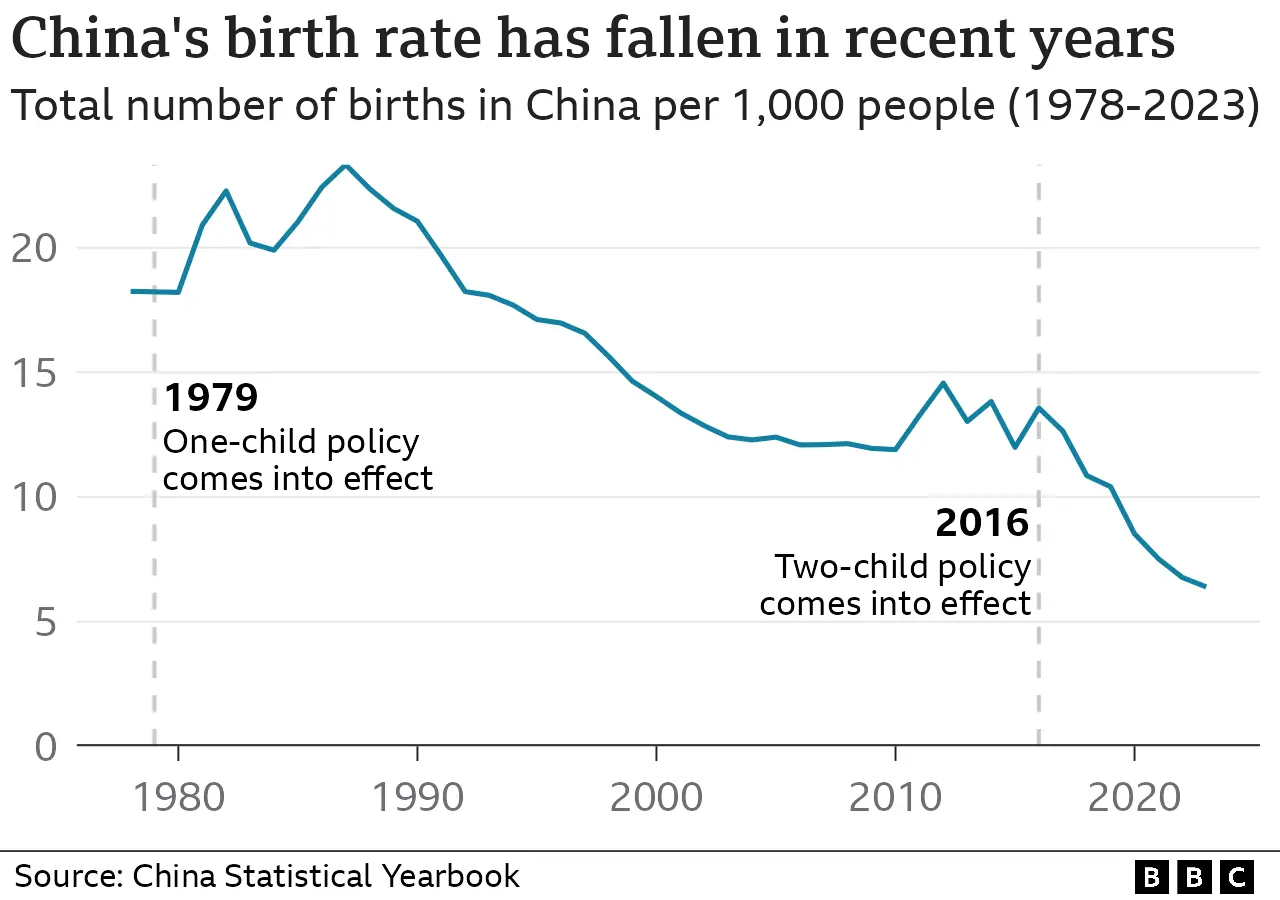China records population decline for second straight year
 Getty Images
Getty ImagesChina's population has declined for a second consecutive year, underscoring concerns about the future growth of the world's second-largest economy.
Data released on Wednesday showed a population of 1.409 billion at the end of 2023 - a 2.08m decrease from 2022.
The most recent decline is double that of the previous year, which marked the first population drop in 60 years.
But experts say this fall is expected given the country's expanding urban class and record-low birth rate.
Beijing on Wednesday said the birth rate was now down to 6.39 per 1,000 people on par with other advanced East Asian nations such as Japan and South Korea.
The country has seen falling birth rates for decades - after imposing a controversial one child-policy in the 1980s to control over-population at the time.
The government lifted the policy in 2015 to try to stem the population fall, and has brought in a series of other incentives too, such as subsidies and payments to encourage people to start families. In 2021, it further relaxed the limit to allow couples to have up to three children.
However, the policies have had little impact, with young people in modern cities citing deterrents like the cost of living and career priorities after a three-year Covid period.
"My husband and I do want to have a kid but we can't afford it for now," said Wang Chengyi, a 31-year-old woman in Beijing.
She told the BBC she and her partner needed to save money for another three years to provide for the costs of having a child - taking into account school expenses in particular.
"I do want to get pregnant while I'm young as it's better for my health. However, I just don't have enough money for now so I have to postpone. It's a shame and I feel panic over it sometimes," she said.
Experts on Wednesday cited the impact of the pandemic in accelerating the decline in new births. However, they suggested that the underlying economic issues were a greater factor.
Chinese internet users also flagged cost pressures on Wednesday.
"If you let people live more easily, with more security, of course there will be more people wanting kids," one user wrote in a top-liked comment on Weibo.

China is following the pattern of other countries that have rapidly deindustrialised, experts say, although the pace of change has been quick.
"It's not a surprise. They've got one of the lowest fertility rates in the world so this is just what happens - the population stops growing and starts to decline," said Prof Stuart Gietel-Basten, a population policy expert at the Hong Kong University of Science and Technology.
"It's kind of locked in now… this is just the next year in this new era of population stagnation or decline for China."
China's economic woes came to the forefront in 2023, with the country battling a widespread property crisis, falling consumer spending and record youth joblessness in the aftermath of the pandemic.
Annual data on Wednesday confirmed the struggles - showing the economy had grown at one of its slowest rates in more than three decades - with GDP expanding at 5.2% to hit 126 trillion yuan ($17.5tn; £13.8tn) in 2023.
This marked the weakest performance since 1990 - excluding the pandemic years - which saw a record-low 3% GDP growth rate in 2022.
China also reported on Wednesday that the youth unemployment rate for December was at 14.1% - after hitting 21.3% in June, after which China temporarily suspended releasing the monthly figures.
The latest population data is likely to reinforce some fears about the economy - with China having long relied on a now ageing workforce as a key driver of its economy.
The country is facing increased pressure on its healthcare and pension systems as its retiree population grows - projected to increase 60% to 400 million by 2035.
But experts say the country has time and resources to manage the transition in its workforce.
"China is no different to other countries that have deindustrialised and moved into the service sector. The population becomes more educated and skilled and healthier, and they want to do other jobs rather than work in factories or construction," said Prof Gietel-Basten.
"The government is aware of this and has planned for this over the past decade and so it's expected to continue with this kind of direction."
Once the world's most populous nation, China was overtaken by India last year according to the UN. India's population stands at 1.425bn.

